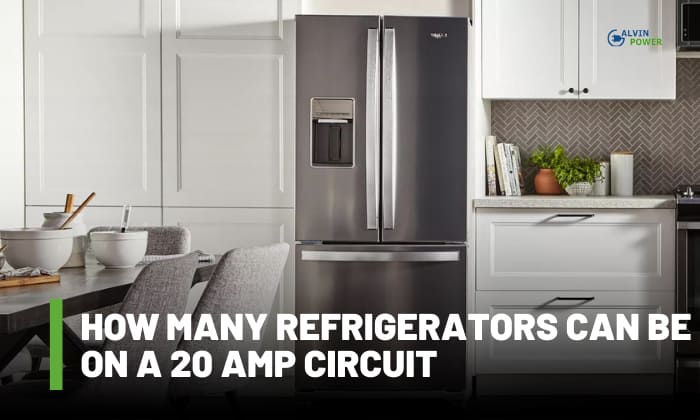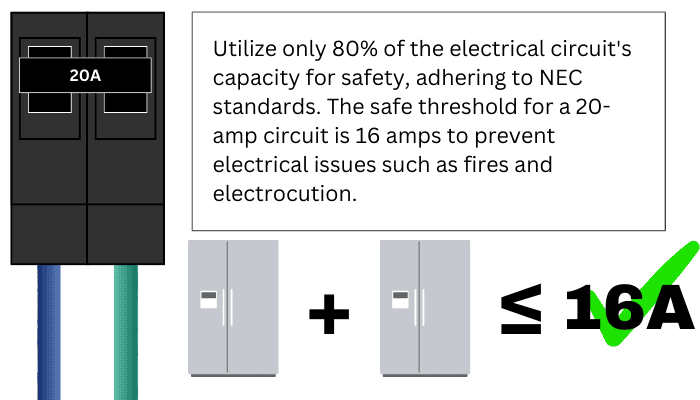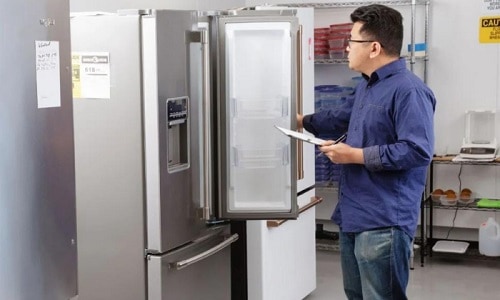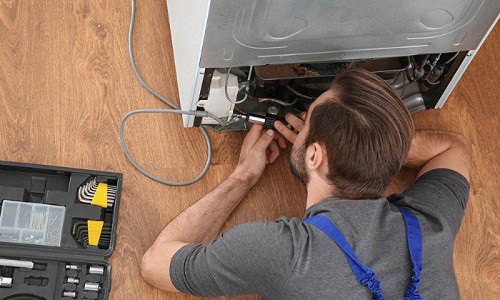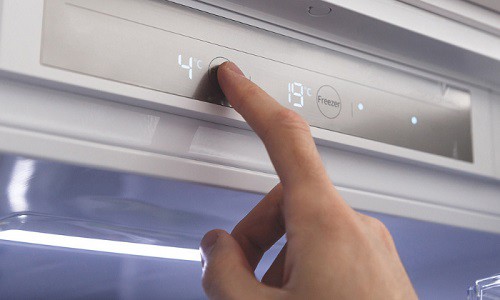A refrigerator is one of the major appliances that usually have a higher electricity demand. In this case, have you ever wondered how many refrigerators can be on a 20 amp circuit?
If you’re looking to connect multiple refrigerator units to a 20-amp circuit, it is important to understand the limitations of the latter. Complete a basic calculation of the refrigerator load to ensure the circuit’s safety and proper functionality.
Table of Contents
Determining the Number of Refrigerators
For many of us, a 20-amp circuit is a common choice for powering a refrigerator. However, a question often arises: Can we connect multiple refrigerators to it?
To find the answer, we must delve into several crucial considerations, including the safe operating capacity of a 20-amp circuit and the total refrigerator electrical requirements.
- Based on standards set by the NEC, using only 80% of the electrical capacity of the circuit is recommended. Consequently, the safe limit of a 20-amp circuit is 16 amps. Exceeding this number may lead to electrical problems like fires and electrocution.
On the other hand, to know how many refrigerators you can connect to this circuit, you must be aware of the refrigerator amps draw. This appliance, whether a standard or mini fridge, demands more current during start-ups.
- You can expect the general amperage to be 3 -6 amps, in which case two fridges on the same circuit will work. However, if the total load of your appliances exceeds 16 amps at startup, don’t use them on the same 20-amp supply.
Calculate the current of each refrigerator using the formula amps = watts/volts, then add the results together.
Furthermore, some factors may cause the unit to use more power.
By carefully considering these factors, you can confidently determine the number of refrigerators that can safely run on a 20-amp circuit.
Factors to Consider
1. Voltage
The voltage rating of a refrigerator plays a significant role in determining its current draw. Generally, refrigerators with higher voltage ratings draw less current than those with lower voltage ratings.
For instance, a 240V fridge may have a current draw that is 50% lower than one with a 120V rating.
2. Wiring
Aside from breaker sizing, ensure your wires can keep up with the fridges’ electrical demands. Do not daisy-chain the appliances together, and make sure you use grounded outlets during installation.
Though it’s best to have separate connections for the fridges, you can minimize the risks of using them on the same circuit by hiring an electrician to complete the setup. The electrician will tell you whether it’s legal to use your appliances this way as well.
3. Temperature Setting
The temperature setting of your refrigerator directly affects its current draw. Lower temperature settings can lead to higher current draw because the refrigerator’s motor continuously maintains the colder temperature.
On the other hand, a slightly higher temperature can help reduce energy usage more effectively than a more significant amp required by lower settings. Optimal temperature levels, such as an average of 40 degrees Fahrenheit, can balance power usage and food preservation.
4. The Temperature of Surroundings
The ambient temperature of the surroundings where the refrigerator is placed can influence its efficiency. In hotter environments, refrigerators may need to work harder to cool their contents, leading to higher power consumption.
To optimize energy efficiency, ensure proper ventilation around the refrigerator and avoid placing it in areas with excessive heat, such as near stoves or other appliances that cook foods.
5. Maintenance
Regular maintenance is crucial for the performance and power efficiency of refrigerators. Failure to clean the inside of the refrigerator and the accumulation of dust and debris on coils and vents can hinder heat dissipation.
As a result, it may consume more power to maintain the desired temperature. Regularly cleaning and maintaining your refrigerator will help optimize its efficiency and reduce energy usage.
Frequently Asked Questions
Does a Refrigerator Need a Special Outlet?
No, refrigerators usually do not need any outlet other than a standard three-prong 120v one. This outlet is sufficient for most refrigerators in the United States. However, it’s important to note that other countries may have different standard voltages, such as 220V instead of 120V.
Does the Refrigerator Need a Dedicated Circuit?
Ideally, a dedicated circuit for refrigerator with AFCI or GFCI protection is recommended. It helps reduce the risk of overloading, which could lead to tripping the breaker or cause potential hazards.
Can You Put a Refrigerator with Other Appliances on a 20 Amp Circuit?
Connecting a refrigerator with other appliances on a 20-amp circuit is not advisable, especially if those other appliances are high-powered like a dishwasher or an electric range. This setup can lead to overloading, potentially causing issues with circuit tripping or compromising the appliances’ performance.
Conclusion
Determining how many refrigerators can be on a 20 amp circuit is essential for maintaining a reliable and efficient electrical setup. However, you should also consider the local electrical code and whether it allows for such an arrangement.
Remember that a single refrigerator typically operates well on a 20-amp circuit. Although it may be tempting to run two refrigerators on the same outlet, it’s advisable to have separate connections for them. Allowing for extra capacity is essential, especially during the start-up phase when the refrigerator may draw significant power.

I am Edwin Jones, in charge of designing content for Galvinpower. I aspire to use my experiences in marketing to create reliable and necessary information to help our readers. It has been fun to work with Andrew and apply his incredible knowledge to our content.

